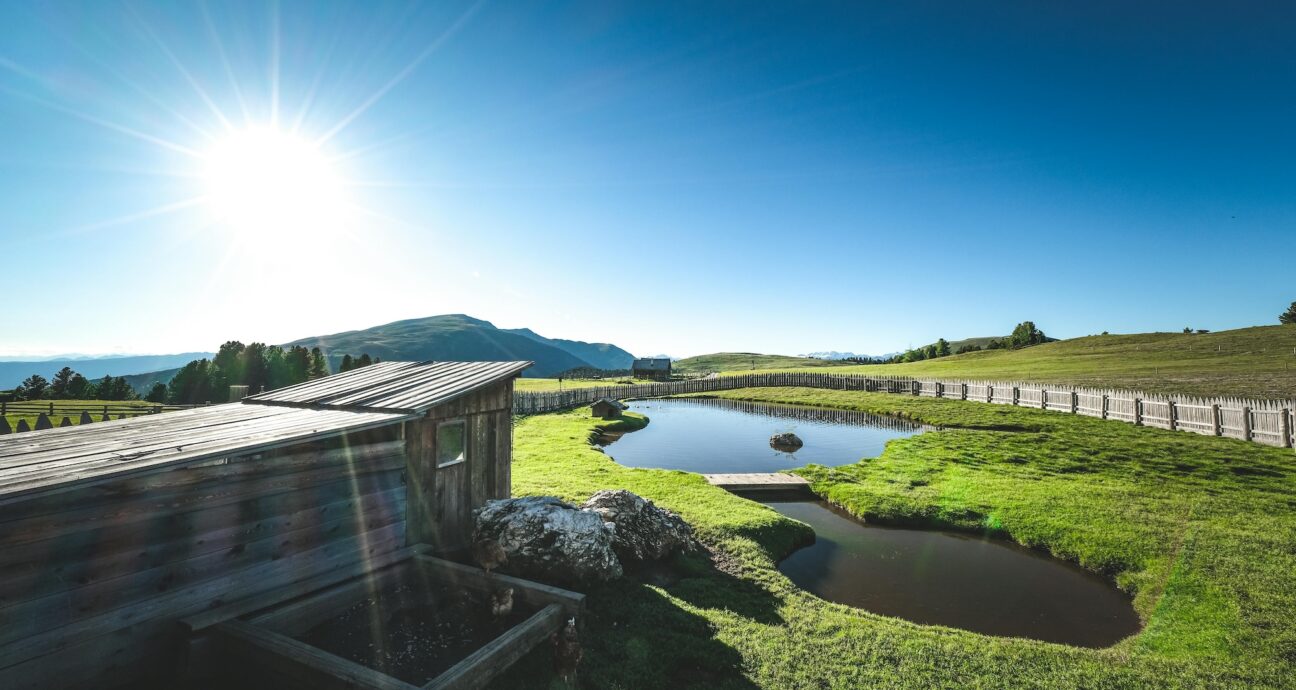The seasons cause dam and pond water quality to change a lot throughout the year. As the year goes on, dams and ponds can fluctuate a lot, and a lot changes beneath the surface.
In this blog, we’re exploring the changes that come with each season. We’ll unpack what to expect and provide tips on what to do in specific seasons to maximise water health.
Spring: Algae Awaken, Weeds Spread
What Happens:
- Longer days and extra sunlight kickstart algae blooms.
- Nutrients that are left over from winter runoff fuel fast weed growth.
- In deeper dams, water may start to stratify (this happens when layers form between warmer surface water and cooler bottom water).
- Some dams may even smell due to rising organic activity.
What To Do:
- Ramp up aeration, it’s so important during this season. It’s especially effective when your aerator is running during mornings and evenings, because it stabilises oxygen before the heat sets in. Running the aerator 24/7 is even better.
- Start increasing Biostim probiotics to boost “good” bacteria that outcompete algae for nutrients. A mix of Biostim Pellets plus some Biostim Liquid works well in spring.
- Stay on top of floating weeds like duckweed and azolla. Early removal or spot treatment is critical since they can double their biomass in as little as 2–10 days.
Pro Tip: Prevention is cheaper than cure. Once algae and weeds take hold, treatment becomes more expensive and less effective, so start tackling the little problems today, e.g. spot treatments, before they become a big problem in Summer.
Summer: Heat, Evaporation & Algae Dominate
What Happens:
- Evaporation rises and dam levels drop.
- Algae (like blue-green algae) can explode, which will turn water green or make it look scummy. Blue-green algae is also toxic so you’ll lose that waterbody for swimming, livestock drinking and spray irrigation until it is treated.
- Oxygen levels plummet at night, stressing fish and livestock.
What To Do:
- Run aerators continuously (24/7 if possible). If you had them on a timer, switch to full-time operation.
- Increase Biostim probiotic dosing. You can’t overdose, but monitor your water for best results. For large water bodies, greater than ¼ acre, we recommend Biostim Powder. For smaller water bodies, you could use Biostim Pellets or Tablets and even intersperse these with Biostim Liquid.
- Add shade. For example: floating plants, shade cloth, or artificial structures reduce sunlight reaching the water.
- Use bore or rainwater to top up water levels when possible to dilute excess nutrients.
- Test for blue-green algae if water looks green, foamy, or has a strong earthy/musty smell.
Pro Tip: Fish gasping at the surface in the early morning means dangerously low oxygen. Add a surface aerator for rapid oxygenation as it acts as an emergency “lifeline” for fish.
Autumn: Turnover Brings Surprises
What Happens:
- Cooler air cools surface layers, which sink and mix with bottom water.
- This “turnover” stirs up gases, sludge, and nutrients.
- Sudden smells or cloudy water are common.
What To Do:
- Keep an eye on odour, clarity, and weed growth.
- Consider reducing aerator run-time (e.g., use timers), but aim for at least 12 hours daily, focusing on overnight and hotter parts of the day.
- Keep adding Biostim probiotics, but you can gradually reduce the dosage as water cools.
- Skim off fallen leaves and debris to prevent future sludge buildup. The Deskuzzer is ideal for this.
Pro Tip: While you can cut aeration hours to save power, continuous aeration delivers the most stable results.
Winter: Runoff, Sediment & The Quiet Season
What Happens:
- Rain and runoff carry soil, nutrients, and animal waste into your dam.
- Cold water slows down algae and bacteria activity.
- Water may look cloudy, but it’s less biologically active.
What To Do:
- Grass buffer strips around dam edges help filter runoff and should be maintained.
- If you have silt traps or sediment fences, make sure to clean them out.
- Run light aeration, timers can save energy, to prevent stratification.
- Drop Biostim dosing to maintenance levels.
- Remove dead weeds and leaf litter to prevent future sludge.
Pro Tip: Winter is the perfect time for dam maintenance. Repair erosion, clean filters, and install new gear like aerators before spring growth starts again.
Year-Round Dam Health Checklist
Here is a checklist to summarise the different seasons and the impact they have:
| Season | Aeration | Biostim Dosing | Key Focus |
| Spring | Ramp up – morning/evening | Medium-high | Control early algae, weed watch |
| Summer | High – daily or 24/7 | High | Prevent algae, maintain
oxygen |
| Autumn | Medium – support
turnover |
Moderate | Manage turnover effects |
| Winter | Low – use timers | Low – monthly
maintenance |
Reduce sediment, prep for
spring |
Final Thoughts
Water quality is never static. Being aware of these changes is important because it shifts with the seasons and weather. By applying season-specific strategies like adjusting aeration, fine-tuning Biostim dosing, and tackling weeds before they spread, you can keep your dam healthy, clear, and productive all year long.
Get FREE Advice / Water Treatment Plans
Want free and tailored advice for your dam? Get in touch with our team for more information, or check out our website to find all the best products for your dam/pond’s health.

